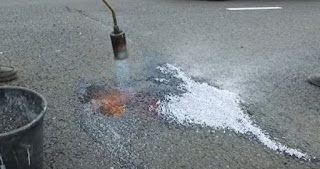Search This Blog
Most Popular
Categories
- Building Construction (84)
- Building Materials (82)
- Columns (2)
- Concrete Beam (3)
- Concrete Construction Techniques (4)
- Concrete Mix Design (9)
- Concrete Repair (14)
- Concrete Slab (10)
- Construction Equipment (16)
- Construction News (7)
- Design of Structures (15)
- Engineering Drawing (1)
- Estimation (3)
- Geotechnical engineering (26)
- Highway Engineering (11)
- Innovations (30)
- Material Testing (10)
- Matrix Analysis of Structures (2)
- Mechanical Engineering (3)
- Strength of Materials (2)
- Structural Analysis (17)
- Structural Design (21)
- Structures (17)
- Transportation Engineering (9)
Thermoplastic Material to Repair Potholes in Asphalt Pavement
Thermoplastic material is used to repair damaged asphalt pavement surfaces by filling the "potholes" or " concave damaged " regions on the road. The technology initially fills the holes with thermoplastic filling material, heats it, and melts it, until the damaged area is sufficiently filled with the material.
The thermoplastic filling is done in layers and is continued until its color matches and is level with the existing asphalt surface.
In this article, we will discuss the method to use thermoplastic material to repair potholes, their types, and their advantages.
How to Repair Potholes Using a Thermoplastic Material?
Step 1: Clean the pothole, and the area that surrounds it. The clean area will be receiving the new patch of thermoplastic material. Remove all the loose particles, chunks of asphalt from the edge of the potholes, sand, dust, etc using a powered blower or compressed air.
Step 2: Make the repair surface moisture free. Heat the pothole with the flame from a propane-fueled torch, until the asphalt darkens.
Step 3: Now, scatter the thermoplastic fill material at a height of 3/4 '' in the pothole from the bottom. Hold the torch 8 '' above it (to prevent scorching) and start to heat the fill material until it is molten and the pieces flow into each other.
 |
| Filling the Potholes with Thermoplastic Material |
Note: Always remember to position yourself with the wind at your back so that the wind moves the heat over the unheated material and moves away without affecting the heating process.
 |
| Heating a Layer of Thermoplastic Chips in a Damaged Area |
Step 4: While the first layer is molten, add the next layer of filler material approximately at 3/4 inches and heat it as mentioned in step 3. Now add the next layer of filler material, until the pothole is packed with a fill material. Do not add layers more than 3/4 inch thick until each layer blends with the underlying layers.
Step 5: Even after packing with the filler material, there are chances that the pavement surface is not level with the filled area. In such situations, wait until the filler material within the pothole hardens. Then add additional thermoplastic filler material to fill any gap and level the surface with the surrounding pavement.
Step 6: Now take the thermoplastic patch in size just larger that the size of the pothole. Using a torch, heat it across the patch to melt to the pavement surface. If the patch is not used sprinkle a few chips to provide skid resistance.
 |
| ADFORS SAINT-GOBAIN Self-Adhesive Patch for Potholes |
Step 7: Insufficient amount of heat to the patch material results in inadequate bonding and material. Water can be sprayed or poured into the area to speed up the cooling.
Thermoplastic Material Properties
The thermoplastic material can be defined as 'Any synthetic polymeric material that has a softening point below 200°C if tested to BS EN ISO 306 Method A120. Specimens for this test may be fabricated from the original polymer where the thickness of the material of the end product is less than 2.5mm.'
They generally have good optical clarity, scratch resistance, dimensional stability, and rigidity. They are do not deteriorate in sunlight and they have good adhesion, are thermoplastic, easy to form, and cut into a variety of shapes. However, they are combustible, are not flexible, suffer from stress cracking, and are not resistant to solvents.Benefits of Thermoplastic Chip Material for Repair of Potholes
- Highly durable
- Heat application permits better bonding with the existing pavement
- Avoid the need for big machinery
- Available in different colors.
Conclusion
You May Also Like to Read:




0 Comments
Commenting Spam Links Are Against Policies